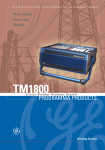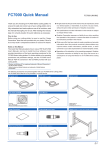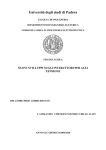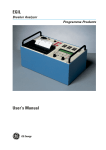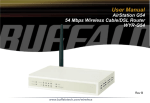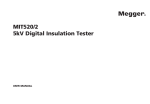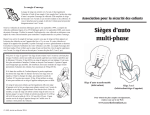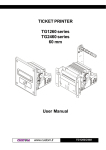Download PROGRAMMA PRODUCTS
Transcript
Innovation Experience Te c h n o l o g y TM1800 TM Circuit Breaker Analyzer System PROGRAMMA PRODUCTS e GE Power Systems TM1800™ CIRCUIT BREAKER High voltage circuit breakers are extremely important for the function of modern electric power supply systems. The breaker is the active link that ultimately has the role of quickly opening the primary circuit when a fault has occurred. Many times, the breaker has to perform its duty within a few milliseconds, after months, perhaps years of idly standing by. Since condition based maintenance has become the established strategy for most owners and operators of electric power supply systems, the need for reliable and accurate field test instruments is obvious. TM1800TM Circuit Breaker Analyzer Capabilities ■ System platform for testing high voltage circuit breakers ■ Expandable modular concept – high flexibility (up to 48 + 48 timing channels) ■ Stand-alone functionality – one toolbox for all breaker testing ■ Designed for Off-line and On-line measurements ■ Analog or digital transducers for contact travel measurements ■ Calibration module for stable accuracy ■ Predefined circuit breaker templates –Automatic testing ■ Enhanced contact timing ■ Active interference suppression - patent pending ■ Integrated static contact resistance measurement ■ Automatic measurement of coil voltage and current ■ Automatic measurement of a and b auxiliary contacts ■ Quick test functions ■ Vibration measurement ■ Temperature measurement ■ CABA backwards compatibility ■ Rugged and reliable for field use ■ Multilingual Human-Machine Interface ■ Enhanced reporting, assessments and archiving of test results ANALYZER SYSTEM Market Trends The Response Many new breaker technologies and designs have been introduced over the past decades. At the same time, the lifetime of an installed circuit breaker is often longer than 40 years. This means that at most sites, the vast range of existing circuit breakers with different configurations present an enormous challenge to the test engineers. In response to all these challenges, GE Power Systems has designed the TM1800 breaker analyzer system. The objective was to incorporate all relevant test functions in one compact unit that should be flexible enough to test any circuit breaker that exists on the market. Another factor has been market driven reorganizations of electric power utilities. Frequently, the established service organizations within utilities have given way to slimmed operations with outsourced maintenance and service. Again, this has meant that a lot of practical know how and background history about specific breakers has been lost along the way. The financial requirements on utilities have tightened as well. Asset optimization has become a priority. The possibility to continue using a costly circuit breaker rather than unnecessarily replacing it with a new is very interesting from this perspective – as long as it does not put the safety and reliability of the electric power supply at risk. This again puts the possibility to quickly and reliably diagnose the breaker’s condition into focus. The reorganizations within the industry mentioned above, (leading to outsourcing of service and maintenance), means that reporting, archiving and evaluation of test results become more critical. Modern service organizations need tools and facilities to provide the breaker owner/operator with reports and recommendations in formats that are suitable. In line with the Programma product line tradition, the new TM1800 Breaker Analyzer System is portable and rugged, making it suitable for use in any type of environment. The concept is a flexible, modular system that can be easily configured for any type of circuit breaker. Distribution breakers with one contact per phase and one operating mechanism can easily be tested. Transmission breakers often have a more complex design with several contacts per phase and separate operating mechanisms. Even here, TM1800 is fully capable of capturing any parameter. For example, when testing circuit breakers with preinsertion resistor (PIR) contacts, the TM1800 automatically measures timing of the main and PIR contacts, as well as the resistance value of the pre insertion resistor. Furthermore, with the TM1800 system, test methods such as static resistance measurement (SRM), dynamic resistance measurement (DRM) and vibration testing are easily integrated in the circuit breaker testing. TM1800 has a straightforward and user-friendly interface, CABA Local. The display is an 8-inch trans-reflecive screen that enhances the use in direct sunlight. You can also use a separate PC with the optional CABA Win software to prepare and evaluate the tests. The user interface, CABA Local, has been designed to facilitate setup and analysis. There are, for example, integrated help functions that guides the user throughout the testing. Special efforts have also been made to reduce the number of connecting leads required. Furthermore, many functions have been automated to reduce the number of manual exercises and breaker operations required to perform a test. As a result, the training needed to use the TM1800 to its full extent is minimized and the time to carry out actual tests is minimal. Timing Measurements Motion Measurement Simultaneous measurements within a single phase is important in situations where a number of contacts are connected in series. Here, the breaker becomes a voltage divider when it opens a circuit. If the time differences are too great, the voltage becomes too high across one contact, and the tolerance for most types of breakers is less than 2 ms. A high-voltage breaker is designed to interrupt a specific short-circuit current, and this requires operation at a given speed in order to build up an adquate cooling stream of air, oil or gas (depending on the type of breaker). This stream cools the electric arc sufficiently to interrupt the current at the next zero-crossover. It is important to interrupt the current in such a way that the arc will not re-strike before the breaker contact has entered the so-called damping zone. The time tolerance for simultaneous measurements between phases is greater for a 3-phase power transmission system running at 50 Hz since there is always 6.67 ms between zero-crossovers. Still, the time tolerance is usually specified as less than 2 ms, even for such systems. It should also be noted that breakers that perform synchronized breaking must meet more stringent requirements in both of the previously stated situations. Speed is calculated between two points on the motion curve. The upper point is defined as a distance in length, degrees or percentage of movement from a) the breaker’s closed-position or b) the contact-closure or contact-separation point. The time that elapses between these two points ranges from 10 to 20 ms, which corresponds to 1-2 zero-crossovers. The distance throughout which the breaker’s electric arc must be extinguished is usually called the arcing zone. From the motion curve, a velocity or acceleration curve can be calculated in order to reveal even marginal changes that may have taken place in the breaker mechanics. Position The A contact must close well in advance of the closing of the main contact. The B contact must open when the operating mechanism has released its stored energy in order to close the breaker. The breaker manufacturer will be able to provide detailed information about this cycle. Closed position Contact closure Arcing zone Stroke There are no generalized time limits for the time relationships between main and auxiliary contacts, but it is still important to understand and check their operation. The purpose of an auxiliary contact is to close and open a circuit. Such a circuit might enable a closing coil when a breaker is about to perform a closing operation and then open the circuit immediately after the operation starts, thereby preventing coil burnout. Damping is an important parameter for the highenergy operating mechanisms used to open and close a circuit breaker. If the damping device does not function satisfactorily, the powerful mechanical strains that develop can shorten breaker service life and/or cause serious damage. The damping of opening operations is usually measured as a second speed, but it can also be based on the time that elapses between two points just above the breaker’s open position. Speed calculation points Damping zone Open position Time Motion Curve 7 tripped. It is important to note, however, that the relationship between the two current peaks varies, particularly with temperature. This also applies to the lowest tripping voltage. 8 6 9 2 3 Dynamic Resistance Measurements (DRM) 4 Example of coil current on circuit breaker: 1 5 1 Trip coil energized 2-3 Armature travel 3-4 Armature operates trip latch 4-5 Armature completes its travel DRM procedures measure variations in contact resistance during breaker operation – not to be confused with static resistance measurement, which measures contact resistance when a breaker is closed. 5 Armature hits stop 6 Change in coil inductance 7 Proportional to DC coil resistance 8 Auxiliary contact opens 9 Current decay Coil Currents These can be measured on a routine basis to detect potential mechanical and/or electrical problems in actuating coils well in advance of their emergence as actual faults. The coil’s maximum current (if current is permitted to reach its highest value) is a direct function of the coil’s resistance and actuating voltage. This test indicates whether or not a winding has been short-circuited. When you apply a voltage across a coil, the current curve first shows a straight transition whose rate of rise depends on the coil’s electrical characteristic and the supply voltage (points 1-2). When the coil armature (which actuates the latch on the operating mechanism’s energy package) starts to move, the electrical relationship changes and the coil current drops (points 3-5). When the armature hits its mechanical end position, the coil current rises to the current proportional to the coil voltage (points 5-8). The auxiliary contact then opens the circuit and the coil current drops to zero with a current decay caused by the inductance in the circuit (points 8-9). The peak value of the first, lower current peak is related to the fully saturated coil current (max current), and this relationship gives an indication of the spread to the lowest tripping voltage. If the coil was to reach its maximum current before the armature and latch start to move, the breaker would not be DRM has a number of applications. On certain types of breakers DRM can be used to measure the shortening of arcing contacts. When breaker contact motion is measured simultaneously with resistance, the results can be used to determine the length of the arcing contact. In some cases, breaker manufacturers can supply reference curves for the type of contact in question. In another application, timing measurements can be performed on a breaker with both sides grounded, and it is difficult (because of practical considerations) to disconnect one side from ground. If a sufficiently high current is used (about 250 A or higher), there will be a noticeable step in the voltage change when the breaker contact closes or opens in spite of the parallel ground connections. Similarly, DRM can be used when a breaker has parallel main contacts. Example of DRM measurement: 1 Motion measurement, phase C 2 Voltage drop, phase C 3 Timing, phase B 4 Timing, phase A 1 5 Start of motion 7 6 Sepeartion of main contact 7 Separation of arcing contact 6 2 5 3 4 5 FLEXIBILITY WITH MODULAR The TM1800 Breaker Analyzer System can determine the condition of any circuit breaker type and model from any manufacturer. Thanks to its modular design it permits user configuration for any application. It also enables upgrading for future circuit breaker applications and designs. The main part of the top panel is designed for the modules. You can configure your TM1800 with the type of module that suit your needs and of course add/replace modules whenever you like. In an“empty” slot there should always be a dummy module. 1 2 3 4 5 6 7 8 On the top panel of the basic unit are the following inputs and outputs: 6 ■ Power supply ■ Trig inputs and trig outputs ■ External outputs for DRM trig and warning signal (alerting nearby personnel that breaker operation is about to take place). ■ Earth (Ground) Connection ■ Sync input and sync output ■ Temperature transducer input ■ Communication interfaces (USB, Ethernet etc.) CONFIGURATION 1 CONTROL 2 TIMING M/R Measures the timing of the main and parallel resistor contacts. Each pair of channels is independent of the others and has its own current limited DC voltage source. Measurement current is limited to 27 mA. Controls the operation of the circuit breaker. It gives a pulse to the coil for close, open and for the motor operation. The module has three contact closures, one for each phase. For 1-phase operation use A for close and B for open, C can be used for motor operation or second trip coil. If two modules are used you can have 3-phase operation with separate voltage for all phases and close and open operation. One channel can measure both the main and the resistor contact and resistance of linear PIR. For DRM measurements you need two channels per break. The control module measures coil current and voltage and timing of auxiliary a and b contacts. ■ Three independent contact functions per module. ■ Sequences C, O, C-O, O-C, O-C-O ■ The function of the sequence is set in CABA Local ■ Six channels per module (grouped 3x2 in pairs with common return) ■ Main contact timing ■ Parallel contact timing ■ Ohmic value of parallel resistors DIGITAL 4 ANALOG 3 The analog module is for measurement of any analog signal measured with an industrial standard transducer with voltage (10V) or current (4-20mA) output. Typical quantities that are measured are for example motion, voltage, current, vibration (acoustic), pressure etc. ■ Three channels per module ■ 10 V and 24 V output ■ Measure with any industrial standard analog transducer 5 TIMING AUX Digital channels for measurement of motion, both linear and rotary with incremental transducer. ■ Six channels per module ■ Measurement ranges transducer resolution up to ±32000 pulses. ■ Power supply: 5 V and 12 V DC 6 ■ Timing of contact or voltage. Polarity insensitive. ■ Six channels per module (each one separately) grouping marked with background colour ■ Safety plug type of connections PRINTER For making printouts. Printouts can also be made via parallel (LPT) or USB output in top module or from PC with CABA Win. Measures timing of any auxiliary contact, for example spring motor auxiliary contacts. A number of different printout formats are available as well as user adapted, both graphic and numeric. You can have printouts in English, German, French, Spanish, Swedish. The printing can be set to automatic printout in CABA Local. ■ Thermal printer sensitive line dot method ■ Paper width 114mm (4") ■ Printing speed 50mm/s (400 dot lines/s) PC-CARD 8 CALIBRATION 7 For on-site calibration of measuring inputs. The calibration module is slightly smaller than the other modules and has a designated module place. Like any other measuring instrument TM1800 has to be calibrated to traceable standards on a regular basis. With the calibration module the unit can be calibrated in field. ■ ■ The calibration module is intended to be in slot 9 in the module panel. You only need to send this module for calibration and you can use TM1800 without it. PC-card module is a non-optional module, which is part of the basic unit. The two PC-card slots are for any type of PCMCIA card i.e. storage, modem, network, wireless communication etc. The module also contains the hard disk for the system for easy extraction and secures storage of recorded data during transport. This module is always in slot 10 in the module panel. ■ Two PC-card slots ■ Type I/II/III PCMCIA cards ■ 20 GB storage capacity on built-in hard drive ■ Optional: Flash disk APPLICATION EXAMPLES Circuit Breaker System with Common Operating Mechanism Minimum configuration of modules for this application is: ■ 1 Control module ■ 1 Timing M/R module ■ 1 Analog module TM1800 Set-up for one main contact and common operating mechanism The drawing shows an analog measurement but it can also be done with a digital module and incremental transducers. The settings in the TM1800 are easy to manage using the internal software, CABA Local. It offers easy access via function keys and the built-in keyboard. It comes with a track ball and large, bright screen which works as well in direct sunlight. 8 Y1 = close coil Y2 = trip coil 1 Y3 = trip coil 2 Below set-up shows complete wiring for pole A. The timing hook-up for remaining pole B and C is done accordingly to pole A. Two control modules (six outputs) are needed to control each coil (Y1/Y2) for every pole. The below set-up shows the wiring of pole A. This also automatically tests timing on the auxiliary contacts that are connected in series to the coils. When on site doing the hook-up, you can get help on how to connect by pressing the i-button (see example on the left). Circuit Breaker System with Separate Operating Mechanism Per Pole TM1800 set-up for two main contacts and one operating mechanism per pole. Motion measurement can be added with an analog or digital module. Minimum configuration of modules for this application is: ■ 2 Control modules ■ 1 Timing M/R module Y1 = close coil Y2 = trip coil 1 Y3 = trip coil 2 SPECIFICATIONS General Specifications are valid after 30 minutes warm up time. Specifications are subject to change without notice. Environment Application Field For the use in high voltage substations and industrial environments Temperature Operating +0°C to 50°C (32°F to 122°F) -20°C to 50°C (-4°F to 122°F), with flash disk Storage & Transport -55°C t +85°C (-67°F to +185°F) Enclosure Class IP41 Humidity 5% - 95% RH, non-condensing. Operating and non-operating Transport ISTA 2A (unit in transport case) Compliance EMC EN 61326:1997+ A1:1998 + A2:2001 Safety EN 61010-1:2001 Certifications CB-Certificate IEC 61010-1:2001 (incl. all national deviations) CE marking Basic unit General Mains input 100 – 240 V +10% AC, 50 – 60 Hz Max power consumption 200 VA Dimensions 513x175x438 mm (20.2"x17.2"x6.9") Weight 15.5 kg (34.2 lbs) Display Type Transreflecting to increase visibility in direct sunlight Diagonal size 21 cm (8") No. of pixels 800 x 600 (W x H) Display mode 256k colour Luminance 350 cd/m2 Keyboard Available languages English, Swedish, Spanish, French, German Pointing device Built-in trackball and mouse buttons External input Trig in Voltage mode Input range 0 – 250 V AC/DC Threshold level User configurable in software in steps of 1 V Time inaccuracy ±0.01% of reading ±0.1 ms Contact mode Output voltage 25 – 30 V DC Output current 20 mA ±5 mA Threshold level 1.5 kΩ ±0.5 kΩ External outputs General No. of channels 3, (TRIG OUT, DRM, WARNING) TRIG OUT Switch Electronic Resolution 1 ms Duration User configurable in software Inaccuracy ±0.01% of reading ±0.1ms Delay from Trig in minimum 5ms Voltage mode Output Voltage 12 V DC ±5% Output Resistance 25Ω + 5Ω Contact mode Making/Breaking range max. 0.5 A Resistive load at 12 V DRM Switch Relay Resolution 10 ms Inaccuracy ±0.01% of reading ±10ms Voltage mode Output voltage 12 V DC ±5% Output current max 0.5 A Contact mode Making/Breaking range max. 0.5 A Resistive load at 12 V WARNING Switch Relay Resolution 10 ms Duration User configurable in software Inaccuracy ±0.01% of reading ±10ms Voltage mode Output Voltage 12 V DC ±5% Output Current max 1 A Contact mode Making/Breaking range max. 1 A Resistive load at 12 V Temperature Interface for HighPrecision 1-wire® Digital Thermometer Communication interfaces PC-card Type I/II/III PCMCIA cards USB Universal Serial Bus ver. 1.1 Ethernet 100 base-Tx Fast Ethernet Printer port LTP, Multi-mode parallel (ECP/EPP/SPP) Serial port RS232, 9-pin D-Sub female External screen SVGA, up to 800 x 600 at 64k color, 2 MB SDRAM Modules Control Module General No. of channels 3 Time base inaccuracy ±0.01% of reading ±0.1 ms Resolution 0.1 ms Bandwidth 5 kHz Measuring time 19 sec at 10 kS/s, 39 sec at 5 kS/s, 200 sec at 10 kS/s (Data compression) Input voltage range 0 – 250 V AC/DC Weight 1.0 kg (2.2 lbs) Non-bouncing switch Function Normally Open/Normally closed, dual direction Continuous current 16 A Max current 60 A during 100 ms with intermittence of 5% Delay from trig in (if applicable) <2.5 ms Current measuring Measuring range ±60 A Resolution 3 mA (At data compression x 2) Inaccuracy ±1% of reading ±0.1% of range Voltage measuring Measuring range ±250 V Resolution 20 mV Inaccuracy ±1% of reading + 0.1% of range Auxiliary contact status/resistance Open circuit voltage 30 V ±10% Short circuit current < 25 mA Status threshold Open > 10 kΩ > close Resistance range 0 – 10 kΩ Resolution 100Ω; 50mΩ 10 kΩ; 5Ω Inaccuracy ±2% of reading ±0.2% of range Timing M/R Module General No. of channels 6, in pairs of 2 Time base inaccuracy ±0.01% of reading ±0.05 ms Resolution 0.05 ms Bandwidth 5 kHz at ≤10 kS/s, 10 kHz at 20 kS/s Measuring time 8 sec at 20 kS/s, 16 sec at 10 kS/s, 1000 sec at 20 kS/s (Data compression) Induction protection Capacitively coupled interference current from surroundings max 20 mA per channel. Active interference suppression – patent pending. Weight 0.8 kg (1.8 lbs) Timing of main and resistive contacts Measuring voltage 55 V ±10% ≤27 mA ±10% Measuring current Status threshold Main < 10Ω <PIR < 10 kΩ < Open PIR resistance measurement Supported PIR types Linear PIR Measuring range 0 Ω – 10 kΩ Inaccuracy ±10% of reading ±0.1% of range Voltage measurement Measuring range ±100 V, ±10 V, ±0.5 V, 20 mV*, 0.4 mV*, 20µ V* ±1% of reading ±0.1% of range * At data compression x 2 Analog Module General No. of channels 3 Time base inaccuracy ±0.01% of reading ±0.025 ms Sampling rate 1 – 40 kS/s Bandwidth 15 kHz Measuring time 10 sec at 40 kS/s, 20 sec at 20 kS/s Transducer Resistance 500Ω - 10kΩ at 10 V output Weight 0.8 kg (1.8 lbs) Output Voltage output 10 V ±5%, 24 V ±5% Current output 0 – 22 mA Current measuring Current meas. range 0 – 22 mA Resolution 0.35 µ A (At data compression x 2) Inaccuracy ±1% of reading ±0.1% of range Voltage measuring Input voltage range 0 – 250 V AC/DC Measuring range ±10 V, ±250 V Resolution 0.3 mV, 20mV Inaccuracy ±1% of reading ±0.01% of range Digital module General No. of channels 6 Supported types Incremental transducers, RS422 Time base inaccuracy ±0.01% of reading ±0.05 ms Measuring time 16 sec at 20 kS/s Weight 0.7 kg (1.5 lbs) Output Voltage 5 V DC ±5% or 12 V DC ±5% Current output < 200 mA Digital input Sampling rate 1 – 20 kS/s Range ±32000 pulses Resolution 1 pulse Inaccuracy ±1 pulse Timing Aux Module General No. of channels 6 Time base inaccuracy ±0.01% of reading ±0.05 ms Resolution 0.05 ms Measuring current < 25 mA Measuring time 16 sec at 20 kS/s, 32 sec at 10 kS/s Weight 0.8 kg (1.8 lbs) Contact Mode Measuring voltage 27 V ±10% Status threshold Closed < 100Ω, Open > 1 kΩ Inaccuracy ±5% of threshold Voltage Mode Input voltage range 0 – 250 V AC/DC Status threshold 10 V Inaccuracy ±0.5 V Printer module General Printer type Thermal printer Paper type Thermal 114 mm Printing speed 50 mm/s (400 dotlines/s) Horizontal resolution 8 dots/mm Vertical resolution 8 dots/mm Enclosure class IP21 Weight 0.8 kg (1.8 lbs) Calibration module General Reference Stability ±250 ppm per year Weight 0.6 kg (1.3 lbs) Resolution Inaccuracy 2 1 Ordering Information Art. No: TM1800 Basic Unit Complete with: Transport case, User’s manual, Mains and Ground cable, USB memory pen Control module Complete with: 3 cable sets, 5 m Timing M/R module Complete with: 3 cable sets, 5 m GA-00850 3 dolphin clips, black 40-08320 6 dolphin clips, red 40-08322 Analog module Complete with: 3 cable sets, 10 m Digital module Cables delivered with transducers Timing Aux module Complete with: 3 cable sets, 5 m Calibration module Complete with: Calibration cable Printer module Complete with: Paper role Dummy module CG-19090 CG-19030 GA-00870 CG-19080 CG-19000 GA-01005 CG-19040 CG-19060 GA-00870 CG-19020 GA-001006 CG-19050 CG-19010 Optional Accessories 4 3 5 6 1 Dolphin Clips 2 Ground Cable 7 3 USB Memory 256 mb 4 Timing M/R Cable 5 Analog Module Cable 6 Timing AUX Cable 8 7 Transducers and Mounting Kit 8 Digital Transducer Cable 9 Cable Reels 9 CABA Win R02A Temperature Sensor with sensor cable, 5 m Motion Transducers – Rotary – Digital 1-phase Ready-to-Use Digital Rotary Transducer 3-phase Ready-to-Use Digital Rotary Transducer Complete with: Mounting and calibration kit Baumer BDH Digital transducer Complete with: Transd.cable & Flex coupling Motion Transducers – Rotary – Analog 1-phase Ready-to-Use Analog Rotary Transducer 3-phase Ready-to-Use Analog Rotary Transducer Complete with: Mounting and calibration kit IP 6501 rotary transducer 357° Complete with: Transducer cable Motion Transducers – Linear – Analog TLH 500 linear transducer, 500 mm (20") travel. LWG 225 linear transducer, 225 mm (9") travel. TS 150 linear transducer, 150 mm (6") travel. Mounting kits Kit for TLH, LWG, TS and IP transducers. Kit for linear transducers, TLH/LWH Kit for vibration transducers Kit for calibration of rotary transducer, IP6501 Breaker-Specific Transducer Mounting Kits For HPL circuit breaker (ABB) For LTB circuit breaker (ABB) For BLG operating mechanism (ABB) Extension cables Analog cable TM1800, XLR female to male, 10 m For Analog and Timing M/R cables and temperature sensor Cable reel, 20 m (65.5 ft) black red blue green yellow Dynamic resistance measurement DRM1000 Injection Control Complete with: Connection box, Cables (red and blue for vehicle battery) and Sensing cables Vibration testing Signal Conditioning Amplifier SCA606 Accelerometer DYTRAN 3200B5 Vibration Analysis Software Separate CABA option for DTW-analysis. CG-8000X XB-31010 XB-39110 XB-39120 XB-39130 XB-31091 XB-31093 XB-31010 XB-30020 XB-30117 XB-30030 XB-39010 XB-39065 XB-39070 XB-39095 XB-39080 XB-39090 XB-39085 GA-01005 GA-00840 GA-00842 GA-00846 GA-00845 GA-00844 BL-90041 BL-13096 XB-32010 BL-8270X TM1800 TM Circuit Breaker Analyzer System PROGRAMMA PRODUCTS e GE Power Systems gepower.com Programma Electric AB Eldarvägen 4, SE-187 75 TÄBY, Sweden Tel: +46 8 510 195 00 Fax: +46 8 510 195 95 [email protected] GEA-13519 ©2003, General Electric Company. All rights reserved. The contents of this document are the property of General Electric Company. No part of this work may be reproduced or transmitted in any form or by any means, except as permitted in written license agreement with General Electric Company. General Electric Company has made every reasonable attempt to ensure the completeness and accuracy of this document. However, the information contained in this document is subject to change without notice, and does not represent a commitment on the part of General Electric Company. The GE logo is a registered trademark of General Electric Company.












